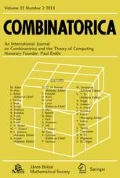Abstract
LetIP[f(n)] be the class of languages recognized by interactive proofs withf(¦x¦) interactions. Babai [2] showed that all languages recognized by interactive proofs with a bounded number of interactions can be recognized by interactive proofs with only two interactions; i.e., for every constantk, IP[k] collapses toIP[2].
In this paper, we give evidence that interactive proofs with an unbounded number of interactions may be more powerful than interactive proofs with a bounded number of interactions. We show that for any polynomially bounded polynomial time computable functionf(n) and anyg(n)=o(f(n)) there exists an oracleB such thatIP B[f(n)] ⊄= IP B[g(n)].
The techniques employed are extensions of the techniques for proving lower bounds on small depth circuits used in [6], [14] and [10].
Similar content being viewed by others
References
W.Aiello, S.Goldwasser and J.Hastad, On the Power of Interaction,Proc. of the 27th IEEE Symposium on Foundations of Computer Science, 368–379, Toronto,1986.
L.Babai, Trading Group Theory for Randomness,Proc. of the 17th ACM Symposium on Theory of Computing, 421–429, Providence,1985.
L. Babai andS. Moran, Arthur-Merlin Games: a Randomized Proof System, and a Hierarchy of Complexity Classes,JCSS,36 (1988), No. 2, 254–276.
R. Boppana, J. Hastad andS. Zachos, Doesco-NP have Short Interactive Proofs?,Information Processing Letters,25 (1987), No. 2, 127–132.
L. Fortnow andM. Sipser, Are There Interactive Protocols forco-NP?,Information Processing Letters,28 (1988), 249–251.
M. Furst, J. Saxe andM. Sipser, Parity, Circuits, and the Polynomial Time Hierarchy,Math. System Theory,17 (1984), 13–27.
O.Goldreich, Y.Mansour and M.Sipser, Interactive Proof Systems: Provers that Never Fail and Random Selection,Proc. of the 28th IEEE Symposium on Foundations of Computer Science, 449–461, Los Angeles,1987.
S.Goldwasser, S.Micali and C.Rackoff, The Knowledge Complexity of Interactive Proofs,Proc. of the 17th ACM Symposium on Theory of Computing, 291–305, Providence,1985, also inSIAM J. on Computing.18 (1989), No. 1, 186–208.
S.Goldwasser and M.Sipser, Private Coins vs. Public Coins in Interactive Proof Systems,Proc. of the 18th ACM Symposium on Theory of Computing, 59–68, Berkeley,1986.
J.Hastad, Almost Optimal Lower Bounds for Small Depth Circuits,Proc. of the 18th ACM Symposium on Theory of Computing, 6–20, Berkeley,1986.
J.Hastad,Computational Limitations of Small Depth Circuits, Ph. D. thesis, MIT,1986.
N.Nisan and A.Wigderson, Hardness vs. Randomness,Proc. of the 29th IEEE Symposium on Foundations of Computer Science, 2–11, White Plains,1988.
M.Sipser, Borel Sets and Circuit Complexity,Proc. of the 15th ACM Symposium on Theory of Computing, 61–69, Boston,1983.
A.Yao, Separating the Polynomial-Time Hierarchy by Oracles,Proc. of the 26th IEEE Symposium on Foundations of Computer Science, 1–10, Portland,1985.
S. Zachos, Probabilistic Quantifiers, Adversaries and Complexity Classes; An Overview,Structures in Complexity Theory, Lecture Notes in Computer Science,233 (1986), 383–398.
Author information
Authors and Affiliations
Additional information
Research done while in the Department of Mathematics at M. I. T. and supported by an ONR graduate fellowship.
Supported in part by NSF Grant DCR MCS8509905.
Research done while at the Laboratory for Computer Science at M. I. T. and Supported by an IBM fellowship.
Rights and permissions
About this article
Cite this article
Aiello, W., Goldwasser, S. & Hastad, J. On the power of interaction. Combinatorica 10, 3–25 (1990). https://doi.org/10.1007/BF02122692
Received:
Issue Date:
DOI: https://doi.org/10.1007/BF02122692




